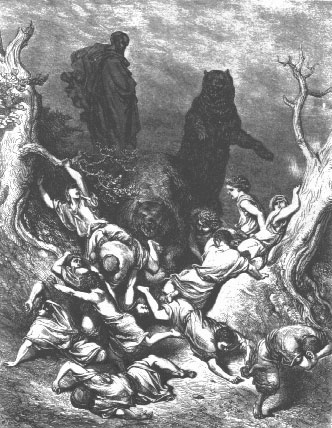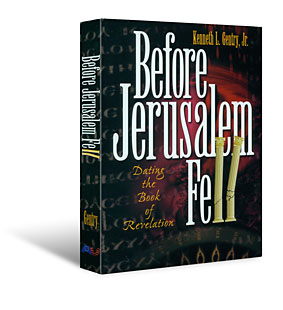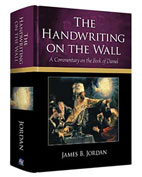Apr
10
2009
So the destruction of AD 70 was not an act of anti-Semitism. Rather it was an act of divine judgment.
…That was the end of Judaism as it had been known for hundreds of years. The priesthood was at an end. The animal sacrifices were at an end. The worship life that centered on Jerusalem and the Temple was at an end. And it has never been restored to our own day. Judaism as we know it today in Minneapolis and New York and Tel Aviv is not the same way of life practiced before AD 70.
What is the meaning of this cataclysmic event for Judaism?
It was a witness to the truth of Christianity. Jesus predicted it. And it came to pass. Christians did not fight against Israel in this revolt. In fact, Christians suffered in Jerusalem with Israel because of the revolt. As far as Rome was concerned Judaism was the tree and Christianity was the branch. If they could destroy the tree of Judaism, they could wipe out Christianity as well. Jews and Christians suffered together in AD 70.
So the destruction of AD 70 was not an act of anti-Semitism. Rather it was an act of divine judgment. That is what Jesus says in Luke 19:43-44: these things happened“ because you did not recognize the time of your visitation,” — that is, you did not recognize the coming of the Messiah. It was God’s testimony that the coming of Jesus was in fact what the book of Hebrews says it was — the replacement of shadows with Reality — Christ himself.
One of the early church fathers, Athanasius (born A. D. 373), put it like this,
It is a sign, and an important proof, of the coming of the Word of God, that Jerusalem no longer stands. . . . For . . . when the truth was there, what need any more of the shadow? And this was why Jerusalem stood till then — namely, that [the Jews] might be exercised in the types as a preparation for the reality.
In other words, one might say, the destruction of the Temple and of Jerusalem was God’s way of saying: “Wake up to the meaning of the book of Hebrews in the New Testament.”
from Jesus: Mediator of a Better Covenant by John Piper, Deember 22, 1996
Comments Off | tags: AD70, John Piper | posted in Quotes, The Last Days
Apr
8
2009

Here is a comment I posted on another blog. The blog accuses God (and the Bible) of cruelty as a basis to reject the Scriptures:
And he [Elisha] went up from thence unto Bethel: and as he was going up by the way, there came forth little children out of the city, and mocked him, and said unto him, Go up, thou bald head; go up, thou bald head. And he turned back, and looked on them, and cursed them in the name of the LORD. And there came forth two she bears out of the wood, and tare forty and two children of them. 2 Kings 2:23-24
Continue reading
Comments Off | tags: AD70, Creation Week, Elijah, Elisha, Joshua, Moses, Remnant | posted in Apologetics, Bible Matrix, Biblical Theology, The Last Days
Apr
8
2009

“But one of the soldiers pierced His side with a spear, and immediately blood and water came out.” – John 19:34
The spear reminds us that Jesus was a victim of both Goliath, the Gentile Sea Beast dressed in chainmail scales (Leviathan), and Saul, the Israelite King turned Land Beast (Behemoth). He was executed as a Balaamite (false prophet) by an apostate Phinehas, the corrupted High Priest who wished to retain the Covenant. The spear was thrust by the conspiracy of the serpent/dragon (Rome), and Adam and Eve (Herod and ‘Babylon’).
The 70 foot high veil in the Temple was torn in two, from top to bottom. The veil was His body (Hebrews 10:20). In Passover/the Red Sea, and in Jordan/Jericho, blood and water opened the door.
“I am the door.” – John 10:9
Comments Off | tags: Crucifixion, High Priest, Temple, Typology, Veil | posted in Biblical Theology, The Last Days
Apr
8
2009
 “It is most remarkable that not only in Revelation do we find large patterns of evidences befitting the AD 60s era, but also even many smaller details. It it surely no accidental similarity that allows us to find not only particular personages (Nero), cultural structures (the Jewish Temple), and historical events (the Neronic persecution and the Jewish War) that harmonise well with the Neronic era, but even time-frames for these that fill out the picture of the era of which John wrote. It can be no other than in the mid- to late AD 60s.”
“It is most remarkable that not only in Revelation do we find large patterns of evidences befitting the AD 60s era, but also even many smaller details. It it surely no accidental similarity that allows us to find not only particular personages (Nero), cultural structures (the Jewish Temple), and historical events (the Neronic persecution and the Jewish War) that harmonise well with the Neronic era, but even time-frames for these that fill out the picture of the era of which John wrote. It can be no other than in the mid- to late AD 60s.”
Kenneth Gentry, Before Jerusalem Fell, p. 255-256
Comments Off | tags: Apocalyptic, Jewish war, Kenneth Gentry, Nero, Revelation, Temple | posted in Quotes, The Last Days
Apr
8
2009
“The failure to understand the Babelic context of Israel’s history results in a failure to understand the purpose of tongues in the New Testament, and a failure to understand the historical transition that took place between A.D. 30 and 70. God judged Babel because if the people were united, nothing would be withheld from them (Gen. 11). Jesus prays that His people would be united, so that nothing will be withheld from us (John 17). It was necessary for Jewish and Gentile believers to overcome the Old Covenant bipolarity and be united, before the Gospel could really go forth in full power. After A.D. 70, with Jew and Gentile united in one Church, nothing can be withheld from us, unless we choose by our sin to be disunited. After A.D. 70, there is no longer any God-instituted historical disunity in operation.”
- James B. Jordan, The future of Israel re-examined
http://www.bullartistry.com.au/lastdays.html (articles 13-15)
Comments Off | tags: Babel, James Jordan, Tongues | posted in Biblical Theology, The Last Days
Apr
8
2009
“…Here we see the third Babylon in all its horror. Both city (Nimrod: Herod + Pilate-Caesar) and tower (priests and Jews) join in putting Jesus to death. Together, they intend that their city and tower will endure, no matter what the God of Heaven says or does. Judgment comes, however. As God came  down on the first two Babylons, the Spirit comes down at Pentecost. Immediately there is a confusion of tongues. Jews of every nation hear the gospel in every language except Hebrew-Aramaic. This time, however, instead of a scattering of lips (religions), there is a unification of lips around the praise of the Father of Jesus Christ. As we shall see below, however, there is another sense in which there is a scattering of different “lips.” The “gift of tongues” continues on and off throughout the Apostolic Age until Jerusalem (the whole circumcision) is destroyed in the destruction of Mystery Babylon in ad 70. The Jews are brought into consternation (1 Corinthians 14:21–22; compare Acts 18:7). Continue reading
down on the first two Babylons, the Spirit comes down at Pentecost. Immediately there is a confusion of tongues. Jews of every nation hear the gospel in every language except Hebrew-Aramaic. This time, however, instead of a scattering of lips (religions), there is a unification of lips around the praise of the Father of Jesus Christ. As we shall see below, however, there is another sense in which there is a scattering of different “lips.” The “gift of tongues” continues on and off throughout the Apostolic Age until Jerusalem (the whole circumcision) is destroyed in the destruction of Mystery Babylon in ad 70. The Jews are brought into consternation (1 Corinthians 14:21–22; compare Acts 18:7). Continue reading
Comments Off | tags: Babel, baby, hero, Pilate, Tongues | posted in Biblical Theology, The Last Days
Apr
8
2009
“God’s creation of Israel was like his creation of the world. The cosmos has an order that will someday be undone. Israel had an order that was undone. And so the un-creation of Israel is sometimes described in the analogous cosmic terms.
Jeremiah was the prophet on duty when Jerusalem fell to the Babylonians and the temple was destroyed. Israel was de-created. No more son of David on the throne. No more temple in Jerusalem. No more people in the land. Jeremiah describes this coming cataclysm in terms of cosmic creation: 4:23 “I looked upon the earth and behold it was formless and void; and to the heavens, and they had no light.”
Jeremiah is not the only prophet to talk like this. And unless we understand that this is part of the prophetic vocabulary, we will come to the book of Revelation and read about stars falling from heaven and other cosmic disasters, and we will not immediately think, “Oh, so Jerusalem and the temple are going to be destroyed and the people removed from the land again. Ah.”
(This is not a new thought here, at all. But American evangelicals have a very persistent misunderstanding in this matter.)”
Keith Ghormley, http://presbyteer.blogspot.com
Comments Off | tags: Creation Week, Eschatology, Jeremiah | posted in Biblical Theology, Quotes, The Last Days
Apr
8
2009
Ezekiel shared his vision with the exiled rulers as a warning. As they saw the Lord’s destruction of the old Jerusalem, they would purify themselves in anticipation of the new Jerusalem promised to them by God (1 John 3:3).
The book of Revelation has the same purpose. Most of the seven churches already contained the seeds of their own destruction—abating love, beasts (false kings), false prophets and spiritual prostitutes. The small judgments Jesus brought in these letters prefigure the major judgments in the letter to the “eighth church,” old Jerusalem, who was in bondage with her children (Galatians 4:24-25).1 The new army of God (the seven churches) saw the bodies of the old mighty men (Judah) fall in the wilderness (Hebrews 3:12-18).
_________________
1 Amos follows the same pattern, dealing with seven nations (including Judah) before he gets to the point and prophesies against Israel, the eighth, to demonstrate that God’s judgment is not biased.
Comments Off | tags: Ezekiel, Revelation, Totus Christus | posted in The Last Days
Apr
8
2009
The book of Daniel begins with the captured vessels from Solomon’s Temple being carried off to Babylon. We assume the ark, with its solid gold lid, was melted down. The golden lampstand, however, shows up at Belshazzar’s feast just before the fall of Babylon to Persia. Cyrus decrees that the Jews can return and rebuild the Temple. They carry the vessels, minus the Ark, across the Great River Euphrates.
Zechariah later sees a flying scroll with the dimensions of the Tabernacle (10 x 20 cubits). These are also the dimensions of the Ark plus cherubim in Solomon’s Temple. The Ark had been offered as an ascension and created a new heaven – unrolled a new scroll. The Restoration Covenant cost the Ark its “life.”
Now to Acts. The human Ark, Jesus, had ascended to heaven and left the “seven churches”, the New Covenant Lampstands with tongues of fire, to rule and conquer Babylon (Jerusalem). The church did so, and we see the firstfruits church army, the “kings from the sunrising” crossing the Great River in Revelation 16, entering a new earth like Joshua over Jordan.
Comments Off | tags: Ark of the Covenant, Babylon, Daniel, Exile, Lampstand, Revelation, Stephen, Tabernacle, Temple, Zechariah | posted in Biblical Theology, The Last Days
Apr
8
2009
“When they persecute you in this city, flee to another. For assuredly, I say to you,you will not have gone through the cities of Israel before the Son of Man comes.” (Matthew 10:23)
“One of the most important lessons any Christian reader of the Old Testament must learn in order to truly understand its message is its connection to the New Testament. Jesus himself said that the whole Old Testament looked forward to his coming suffering and glorification (Luke 24:25-27, 44-48), but it is surprising how many ignore this crucial principle of interpretation.”
Tremper Longman III, Robert H. Gundry Professor of Religious Studies at Westmont College, author of Making Sense of the Old Testament
Comments Off | posted in Quotes, The Last Days





























